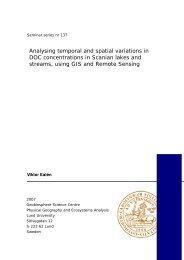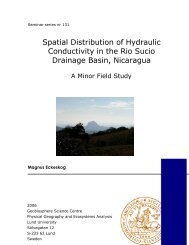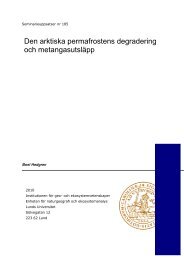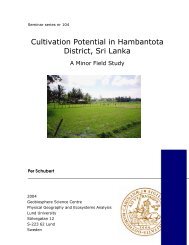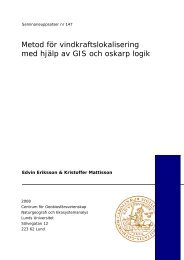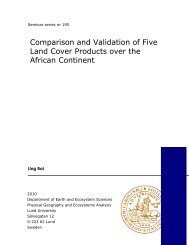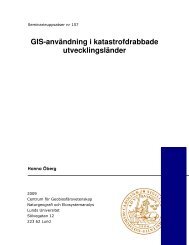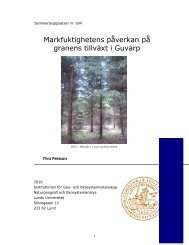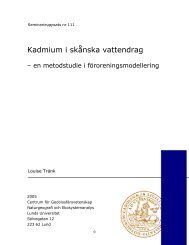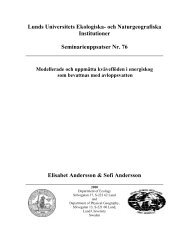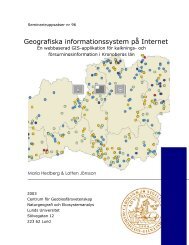Finding Potential Sites for Small-Scale Hydro Power in Uganda: a ...
Finding Potential Sites for Small-Scale Hydro Power in Uganda: a ...
Finding Potential Sites for Small-Scale Hydro Power in Uganda: a ...
You also want an ePaper? Increase the reach of your titles
YUMPU automatically turns print PDFs into web optimized ePapers that Google loves.
UTM Zone 36N projection. The study area is located <strong>in</strong> UTM zone 35, but is <strong>in</strong> all mapsextrapolated to be <strong>in</strong> same zone as the rest of the country. When us<strong>in</strong>g a GPS <strong>in</strong> thestudy area, you will receive coord<strong>in</strong>ates <strong>in</strong> zone 35, which there<strong>for</strong>e differs from thecoord<strong>in</strong>ates <strong>in</strong> the maps. The knowledge about this was received later and there<strong>for</strong>e weabandoned the use of GPS, which reduced the pace of our evaluation.The fact that the use of GPS no longer was an alternative to f<strong>in</strong>d the potential sites andthe <strong>in</strong>ability to unh<strong>in</strong>dered visit all sites <strong>in</strong> the terra<strong>in</strong>, we decided to evaluate sites <strong>in</strong>vic<strong>in</strong>ity of roads and smaller villages. This was done despite the knowledge that a certa<strong>in</strong>degree of tarmac bias could occur, which would make the selection of evaluation sitesstatistically <strong>in</strong>correct. On the other hand, there is no <strong>in</strong>terest <strong>in</strong> potential sites far awayfrom roads, s<strong>in</strong>ce it will make transportation of construction material more complicatedand expensive.The reason to why not more than three sites fulfilled the required criteria of head andpermanent flow, at the evaluation, was not our algorithm, but <strong>in</strong>correct <strong>in</strong>put data. Whenper<strong>for</strong>m<strong>in</strong>g the evaluation we found that all watercourses, except these three, wereseasonal and not permanent as supposed to <strong>in</strong> the <strong>in</strong>put data. This probably arose as aclassification error when digitiz<strong>in</strong>g the watercourse layer. Despite that we did not f<strong>in</strong>dpermanent watercourses, every visited site clearly showed signs from water activity,which means that the data is correct regard<strong>in</strong>g location. Of course this should have beencritically questioned be<strong>for</strong>e per<strong>for</strong>m<strong>in</strong>g the analysis. We should also have asked the NFAwhat the requirements are <strong>for</strong> a watercourse to be classified as permanent. None of thiswas done, <strong>in</strong>stead we committed the mistake of assum<strong>in</strong>g that the data was correct.We <strong>in</strong>terpreted the conditions <strong>in</strong> the study area mentioned earlier, regard<strong>in</strong>g precipitationand topography to be favorable <strong>for</strong> watercourses suitable <strong>for</strong> small-scale hydropower.The result from the evaluation showed the opposite s<strong>in</strong>ce we hardly found anywatercourses at all <strong>in</strong> the area, which surprised us. The reason <strong>for</strong> this is partly because ofthe <strong>in</strong>correct classification but also because of the properties of the volcanic geology.Accord<strong>in</strong>g to Nyiraneza and Hoellhuber (2002) the absence of surface water is caused byhigh and <strong>in</strong>homogeneous permeability of soil and underly<strong>in</strong>g geological <strong>for</strong>mations.Someth<strong>in</strong>g we came across when evaluat<strong>in</strong>g the potential sites, which also can expla<strong>in</strong> theabsence of surface water, is the construction of subsurface water pipes. The water is ledthrough pipes from spr<strong>in</strong>gs down to the village center, where it supplies the villagers withdr<strong>in</strong>k<strong>in</strong>g water.62



